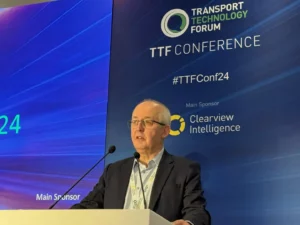The Department for Transport has a morning of updates at the Transport Technology Forum in Leicestershire.
Follow our live blog of key points here:
9.36
Darren Capes of the DfT thanks Clearview Intelligence for its sponsorship of the event.
He gives a history of the TTF and its importance in the sector, and hints on more detail on the £70 million signals funding tomorrow.
He plans to set up regional groups around traffic signals to bring the signals community together, to allow government and signals suppliers and signals owners (local authorities) to work together.
More on signals numbering, and a national database of traffic signals will be published shortly.
TTF has launched the Supplier Directory – to build a list of innovators to matchmake between those who want to innovate and those who can innovate.
9.45
Michael Dnes of DfT talks about the National Parking Platform.
He points out how many people have multiple parking apps on their phones. The implementation was “quite chaotic” where people needed different apps to park in different places which users find frustrating. He explains how the NPP is a hub that sits in the middle of all the parking apps. This lets users pick their app, reduces procurement requirements. The NPP is not an app, but is linking up existing apps and existing parking in a new and better way.
He points out this was used yesterday.
This is already running in seven locations as early access pilots with more to come.

This will help people make new interfaces for users, such as a parking app for disabled motorists.
It has one data stream joining everything up to be plug and play.
Tolling, clean air zones, EV charging etc can also interface in the NPP – so it becomes a platform to pay for driving costs.
Full operation planned for October, in time for the TTF Autumn Update in November.

10.00
Paul Chandler from DfT and Gareth Tilley of PA Consulting update on Digital Traffic Regulation Orders.
This is all about centralised digitisation of traffic orders – they are the rules of the road, which will need to be digitised for future technologies.
Currently beta testing D-TROs.
The legislation is the Automated Vehicles Bill which should be passed next month, and this makes it a legal requirement for TROs to be submitted into the central platform, with it coming into law from 1 April 2025, with organisations needing compliant software to send permanent and temporary orders into the D-TRO service.
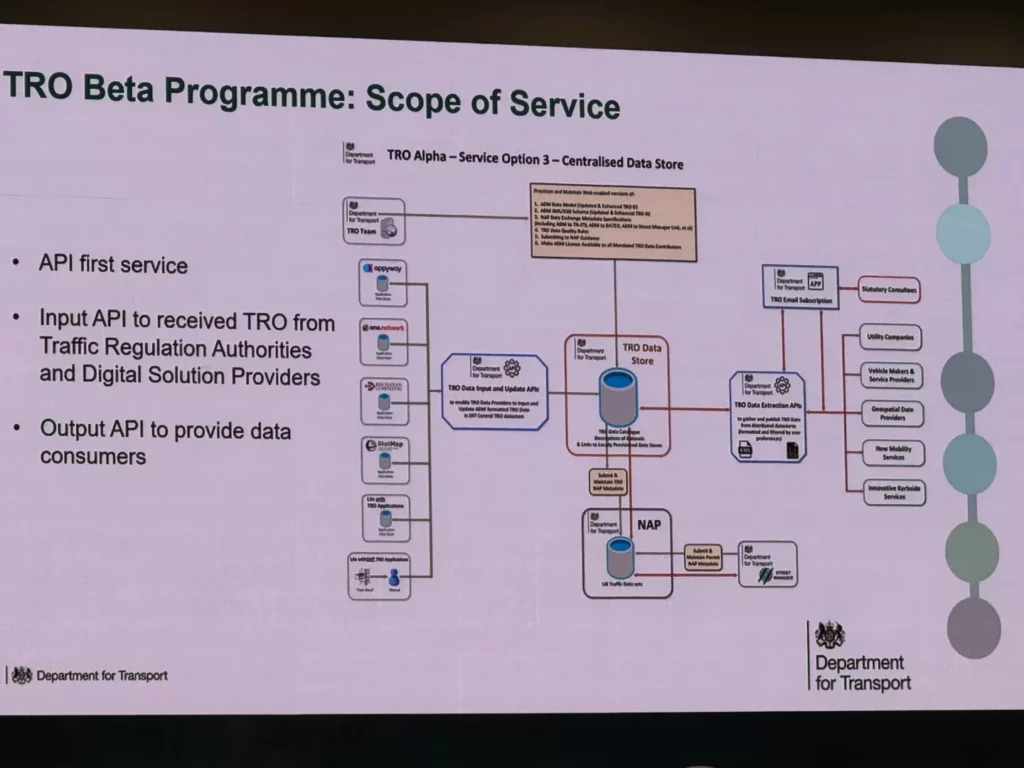
A small group of authorities will test the software during the summer, with the D-TRO service will be opened up to Traffic Regulation Authorities by the end of the year.
The legal requirement is for new orders, but old orders can be included too.
10.11
Matt Coleman, Head of Data Policy at the DfT talks about transport data.
Transport Data Strategy lays the foundations, themes and principles around data to improve data sharing and interoperability.
Transport Select Committee inquiry into the future of transport data around rail, highways, freight and maritime. DfT will give oral evidence on 3 July.
Smart data is mentioned in the budget – this is data portability. Transport is one of seven priority sectors, giving economic benefits, customer value, efficiencies, encouraging green behaviours. Visibility within the transport sector is understandably low, so will do a “discovery” about what this means for the sector. Potential use cases are MaaS, multi-modal and multi-operator ticketing, EV charging, parking, freight, last mile delivery.
There will also be a discovery into Big Data, which is typically not held by DfT so they need to explore what others hold that could be freely open or shared. This will start broad with all modes, data from senosrs, apps, transport-related data. It will explore availability, quality, benefits, commercials, costs, risk and also potential use cases. This should be complete by the autumn.
Highlighted the open data resource on the TTF website.
10.21
The issue of 2G and 3G switch off and its effect on transport is highlighted now by Michaela Nelson, head of future telecoms and digital connectivity from the DfT.
The effect could be on eCall, sensors for infrastructure monitoring, parking space and ticketing, EV charging apps and Bus Open Data Service.
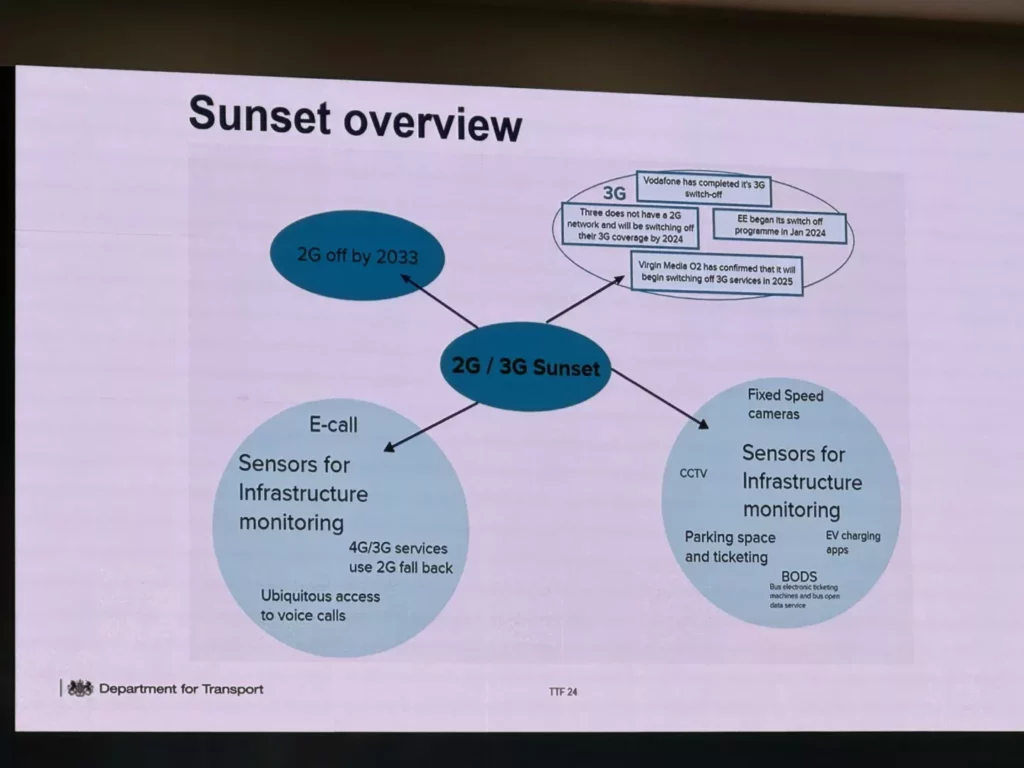
Although 2G is an older technology, it will be switched off by 3G because many calls are made over 2G and it has a ubiquitous wider coverage across the UK.
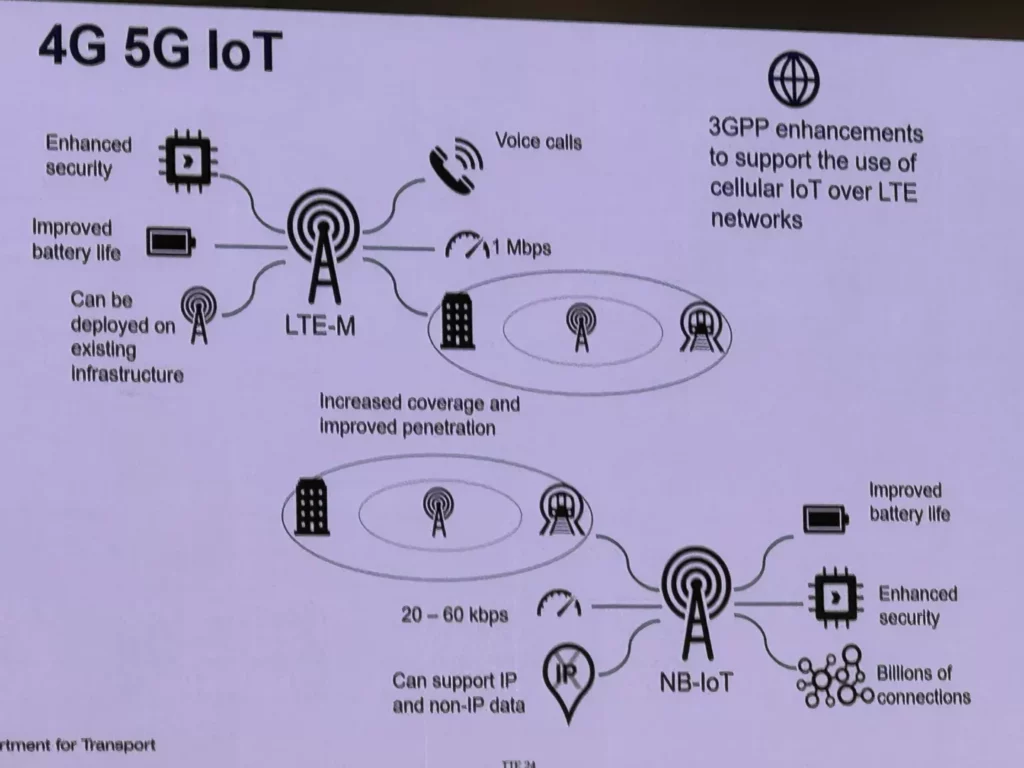
There is a value to new technology around security, coverage and penetration, less energy use.
There is a lot coming online to replace 2G and 3G that will be better but there will be “some pain” during the transition.
10.33
Alex Mindell from the DfT looks at the Power of AI in transport.
He explained the building blocks of AI are data, algorithms and computing power.
What is on the horizon? One is around optimisation, such as route optimisation around roads, flights, to make us more efficient in terms of using our transport resources, rail timetabling etc. This will be useful for recovering from disruption using historical and realtime data.
It will help with planning, such as where we place our EV chargers to better understand where we put them, where we should put new bus routes, railway stations etc.
AI will help with automation and improve safety and efficiencies, while less talked about is in the construction industry, plus predicted maintenance and automated inspection.
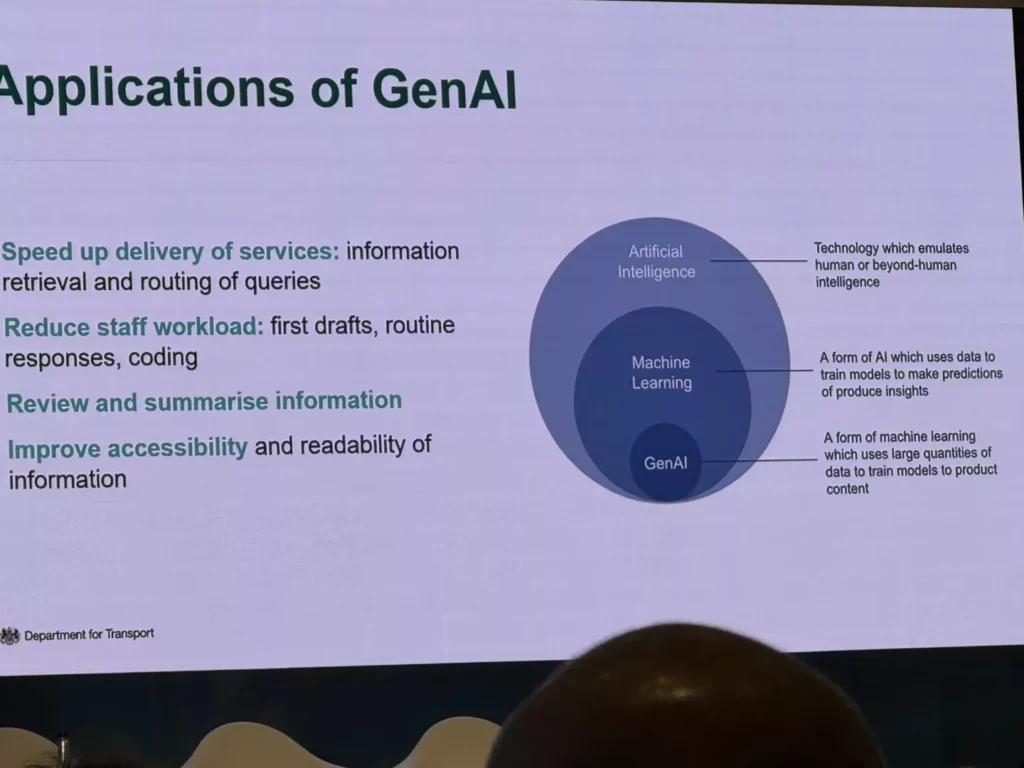
Common AI challenges include data, outliers, explainability, trust, bias and “human machine teaming”.
The AI strategy is to create the foundations for this rapid change in the sector. “Responsible AI embedded in a resilient transport system delivering cheaper, cleaner and quicker journeys for all”.
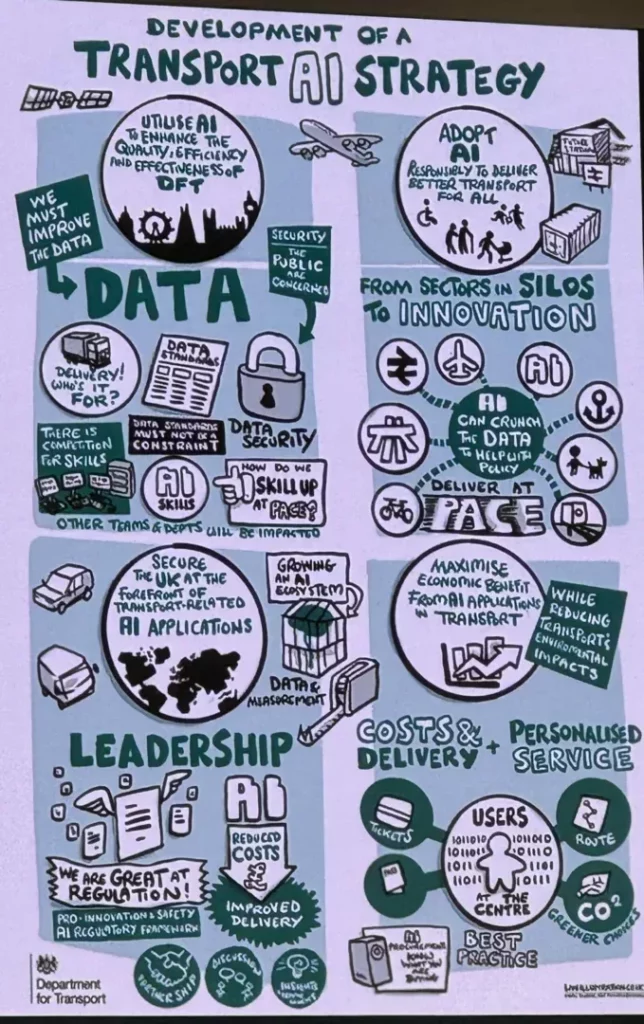
They plan to set foundations, signal to industry the commitment, contextualise and reinforce the data journey, work with industry to tease out longer-term goals and identify where AI can support transport.
10.50
Raphael Sicking of WSP talks about Connected Services Architecture, a research and development project.
This is one of several DfT initiatives around NPP, plan for drivers, roads to tomorrow, D-TROs, ITMF and AV legislation as well.
He outlines the potential benefits around connected services – Net Zero, safety, efficiencies/public savings, increased public transport use and private sector readiness.
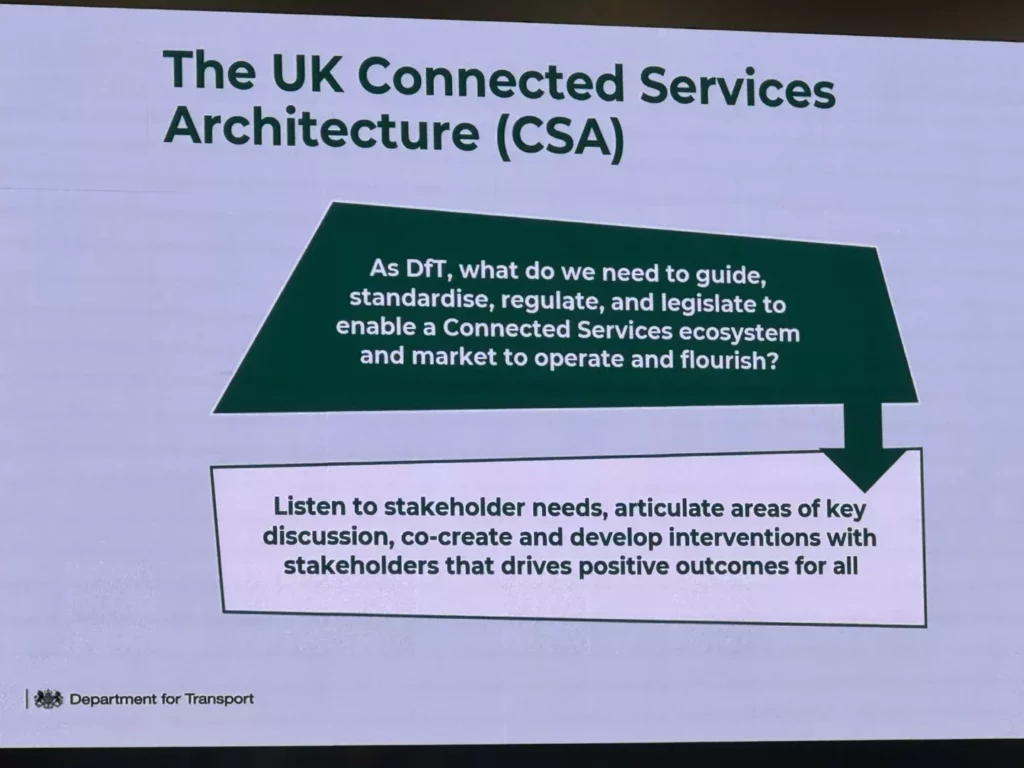
DfT is engaging with stakeholders including: Transort Scotland, Transport for Lndon, Welsh Government, Department for Infrastructure NI, TfWM, TfGM, National Highways, TOPAS, ITS UK, TTF etc.
They recognised a need for the government to accelarate around tech, standards, connectivity, data, leadership.
Have identified four development areas: roles and responsibilities and governance; security, trust, assurance and awareness; network connectivity, coverage and data exchange; technical standards, development and deployment.
Pointed to a survey which people are encouraged to take part in.
They are currently developing a business case for interventions “that DfT or their champions can champion” then are looking at the strategic tone to industry and sector on DfT’s ambitions.






